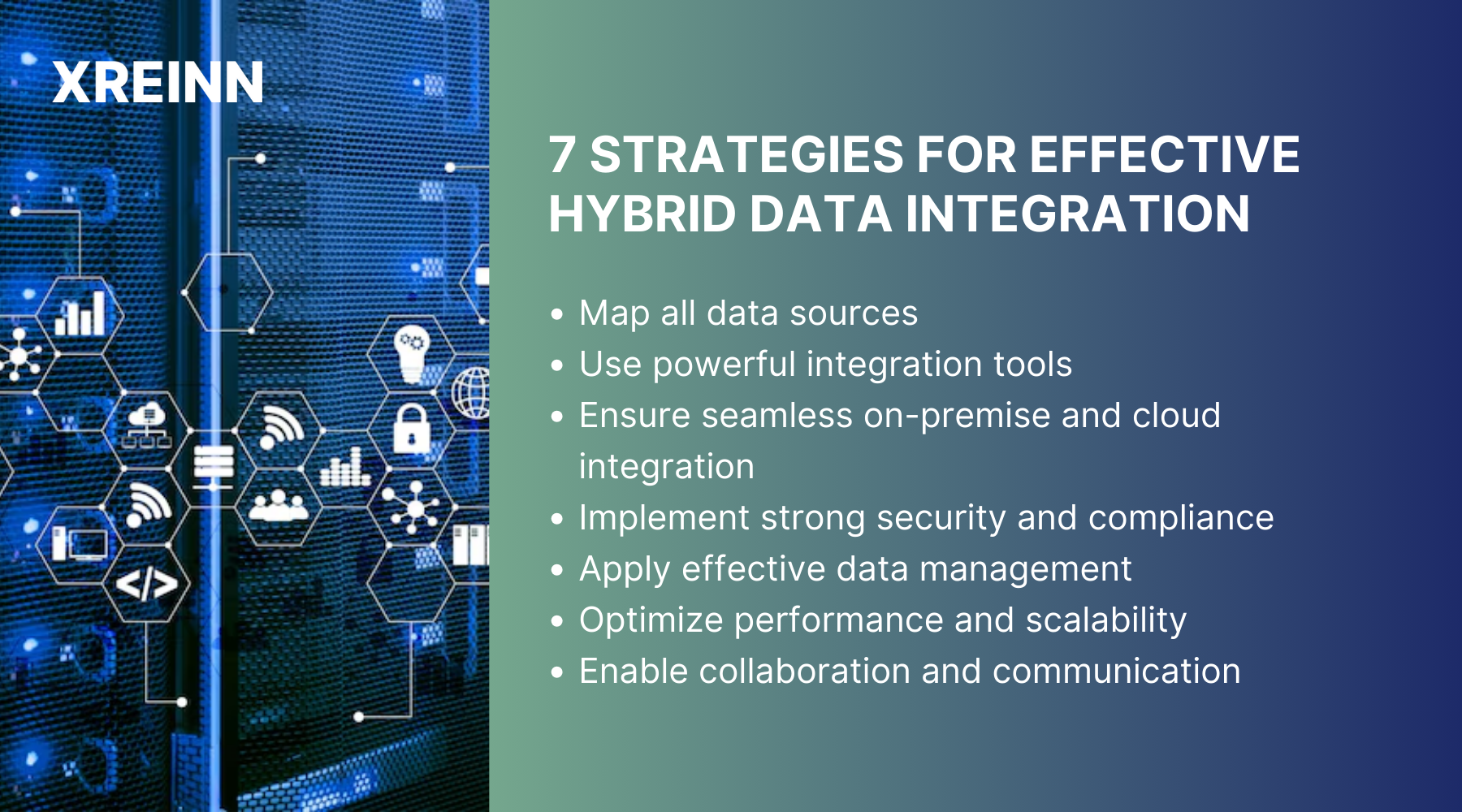Data Integration
7 Essential Strategies for Effective Hybrid Data Integration
Aug 02, 2024
Understanding hybrid data integration is essential for any business trying to fully use its data assets. With the complication of managing both on-premise and cloud data sources, it's important to implement strategies that ensure seamless, secure, and scalable integration.
Effective hybrid data integration allows businesses to unify different data streams, enabling comprehensive analysis and more analytical decision-making. As data volumes grow, the ability to integrate smoothly becomes a key factor in maintaining operational efficiency. Additionally, strong integration frameworks help safeguard sensitive information, ensuring compliance with regulations, and enabling innovation by providing a unified data view.
This guide presents you with the seven advanced strategies to improve your hybrid data integration efforts, transforming your data operations.
7 Strategies for Effective Hybrid Data Integration

1. Understand Your Data Environment
Effective hybrid data integration starts with a thorough understanding of your data environment. Begin by closely mapping out your data sources, including all on-premise and cloud data repositories. This involves cataloging your data, understanding data flows, and recognizing dependencies to create a cohesive integration strategy.
For those with advanced needs, use automated data discovery tools to streamline this process. Tools like Apache Atlas or Collibra offer deep insights into data lineage, showing where your data originates, how it transforms, and its final destination.
These insights are important for setting up efficient data pipelines and avoiding common integration pitfalls. By gaining a clear understanding of your data environment, you can lay a solid foundation for seamless hybrid data integration.
2. Choose the Right Hybrid Integration Tools
Not all tools are created equal, and your choice can greatly impact the efficiency of your integration efforts. Focus on tools that offer strong capabilities in real-time data processing, scalability, and security.
Consider tools like MuleSoft Anypoint Platform, which is best in connecting various data sources through APIs, or Talend, known for its extensive data transformation and integration capabilities. Look for platforms that support hybrid environments natively, providing seamless transitions between on-premise and cloud systems. Evaluate each tool based on your specific use cases, performance requirements, and ease of integration with your existing tech stack.
3. Ensure Seamless On-Premise and Cloud Integration
Integrating on-premise and cloud systems smoothly requires a careful approach. Start by ensuring that your network architecture supports hybrid connectivity. Use hybrid cloud platforms like Microsoft Azure Arc or AWS Outposts that bridge your on-premise infrastructure with cloud services.
Use integration patterns such as data replication, data virtualization, and event-driven architecture. Data replication ensures that your on-premise and cloud databases remain in sync, while data virtualization provides a unified view of data without physical movement.
Event-driven architecture, powered by tools like Apache Kafka, enables real-time data integration and processing, ensuring that changes in one system are immediately reflected across your environment.
4. Organize Data Security and Compliance
When it comes to hybrid integration, keeping your data secure and compliant is essential. You must safeguard your data both in transit and at rest. Implement end-to-end encryption using protocols like TLS for data in transit and AES for data at rest. Additionally, apply strong identity and access management (IAM) practices to control who can access what data.
Compliance is equally important. Ensure your integration processes adhere to relevant regulations such as GDPR, HIPAA, or CCPA. Utilize data masking and tokenization techniques to protect sensitive information. Regularly audit your integration workflows and perform vulnerability assessments to identify and lessen potential security risks.
5. Implement Effective Hybrid Data Management
Effective data management in a hybrid environment involves performing data across various platforms while maintaining consistency and integrity. Implement data governance frameworks to define policies, roles, and responsibilities for data management. Use master data management (MDM) solutions to ensure a single source of truth across your hybrid environment.
For advanced data management, consider using data fabric architectures that provide a unified data management framework. Data fabric uses metadata, machine learning, and automation to manage and optimize data across distributed environments. Tools like IBM Cloud Pak for Data offer comprehensive data fabric solutions, enabling you to manage, govern, and integrate data seamlessly.
6. Optimize Data Performance and Scalability
Optimizing performance and scalability is important for effective hybrid data integration. Start by implementing efficient data partitioning and sharding techniques to distribute data across multiple nodes, improving query performance and load balancing. Use distributed computing frameworks like Apache Spark or Flink for real-time data processing and analytics.
Scalability can be improved by using cloud-native services that automatically adjust resources based on demand. Use autoscaling features provided by cloud platforms to handle varying data loads without manual intervention. Monitor performance metrics continuously and use predictive analytics to anticipate and address performance bottlenecks before they impact your operations.
7. Enable Collaboration and Communication
Successful hybrid data integration depends on collaboration and communication among your teams. Enable a culture of collaboration by encouraging cross-functional teams to work together on integration projects. Use collaborative tools like Jira or Trello to track tasks, manage workflows, and ensure everyone is aligned.
Hold regular meetings to discuss progress and challenges. Encourage open feedback and consider DevOps practices to improve collaboration between your teams.
Conclusion
Mastering hybrid data integration involves a strategic and advanced approach. By understanding your data environment, choosing the right tools, ensuring seamless integration, enabling security and compliance, implementing effective data management, optimizing performance, and building collaboration, you can transform your data operations. These strategies will help you unlock the full potential of your hybrid data environment, enabling your business to grow in an increasingly data-driven world.

Data Analytics
Jun 27, 2024Master key concepts in data analytics with practical tips to enhance decision-making and achieve success in your projects and professional growth

Data Analytics
Jul 01, 2024Learn the essential stages of the data analytics workflow to turn your data into valuable business insights and drive growth.

